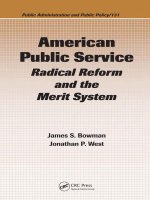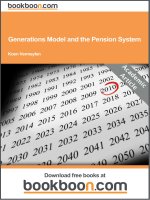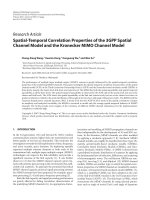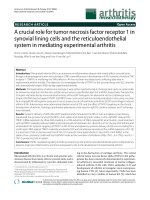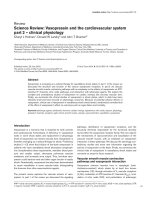generations model and the pension system
Bạn đang xem bản rút gọn của tài liệu. Xem và tải ngay bản đầy đủ của tài liệu tại đây (991.5 KB, 19 trang )
Generations Model and the Pension
System
Koen Vermeylen
Download free books at
Koen Vermeylen
Generations Model and the
Pension System
BusinessSumup
Download free eBooks at bookboon.com
Generations Model and the Pension System
© 2008 Koen Vermeylen & BusinessSumup
ISBN 978-87-7681-287-4
Download free eBooks at bookboon.com
Contents
Generations Model and the Pension System
Contents
1.
Introduction
5
2.
The overlapping generations model
6
3.
The steady state
9
4.
Is the steady state Pareto-optimal?
10
5.
Fully funded versus pay-as-you-go pension systems
12
6.
Shifting from a pay as-you-go to a fully
15
funded system
7.
Conclusion
18
References
19
Fast-track
your career
Masters in Management
Stand out from the crowd
Designed for graduates with less than one year of full-time postgraduate work
experience, London Business School’s Masters in Management will expand your
thinking and provide you with the foundations for a successful career in business.
The programme is developed in consultation with recruiters to provide you with
the key skills that top employers demand. Through 11 months of full-time study,
you will gain the business knowledge and capabilities to increase your career
choices and stand out from the crowd.
London Business School
Regent’s Park
London NW1 4SA
United Kingdom
Tel +44 (0)20 7000 7573
Applications are now open for entry in September 2011.
For more information visit www.london.edu/mim/
email or call +44 (0)20 7000 7573
www.london.edu/mim/
Download free eBooks at bookboon.com
4
Click on the ad to read more
Introduction
Generations Model and the Pension System
1. Introduction
This note presents the simplest overlapping generations model. The model is due
to Diamond (1965), who built on earlier work by Samuelson (1958).
Overlapping generations models capture the fact that individuals do not live
forever, but die at some point and thus have finite life-cycles. Overlapping generations models are especially useful for analysing the macro-economic effects of
different pension systems.
The next section sets up the model. Section 3 solves for the steady state. Section
4 explains why the steady state is not necessarily Pareto-efficient. The model is
then used in section 5 to analyse fully funded and pay-as-you-go pension systems.
Section 6 shows why a shift from a pay-as-you-go to a fully funded system is never
a Pareto-improvement. Section 7 concludes.
Download free eBooks at bookboon.com
5
The overlapping generations model
Generations Model and the Pension System
2. The overlapping generations model
The households Individuals live for two periods. In the beginning of every
period, a new generation is born, and at the end of every period, the oldest
generation dies. The number of individuals born in period t is Lt . Population
grows at rate n such that Lt+1 = Lt (1 + n).
The utility of an individual born in period t is:
Ut = ln c1,t +
1
ln c2,t+1
1+ρ
with ρ > 0
(1)
Download free eBooks at bookboon.com
6
Click on the ad to read more
The overlapping generations model
Generations Model and the Pension System
c1,t and c2,t+1 are respectively her consumption in period t (when she is in the
first period of life, and thus young) and her consumption in period t + 1 (when
she is in the second period of life, and thus old). ρ is the subjective discount rate.
In the first period of life, each individual supplies one unit of labor, earns labor
income, consumes part of it, and saves the rest to finance her second-period retirement consumption. In the second period of life, the individual is retired, does not
earn any labor income anymore, and consumes her savings. Her intertemporal
budget constraint is therefore given by:
c1,t +
1
c2,t+1 = wt
1 + rt+1
(2)
where wt is the real wage in period t and rt+1 is the real rate of return on savings
in period t + 1.
The individual chooses c1,t and c2,t+1 such that her utility (1) is maximized
subject to her budget constraint (2). This leads to the following Euler equation:
c2,t+1 =
1 + rt+1
c1,t
1+ρ
(3)
Substituting in the budget constraint (2) leads then to her consumption levels in
the two periods of her life:
c1,t =
c2,t+1 =
1+ρ
wt
2+ρ
1 + rt+1
wt
2+ρ
(4)
(5)
Now that we have found how much a young person consumes in period t, we can
also compute her saving rate s when she is young:1
s =
=
wt − c1,t
wt
1
2+ρ
(6)
The firms Firms use a Cobb-Douglas production technology:
Yt = Ktα (At Lt )1−α
with 0 < α < 1
(7)
where Y is aggregate output, K is the aggregate capital stock and L is employment (which is equal to the number of young individuals). A is the technology
Download free eBooks at bookboon.com
7
The overlapping generations model
Generations Model and the Pension System
parameter and grows at the rate of technological progress g. Labor becomes
therefore ever more effective. For simplicity, we assume that there is no depreciation of the capital stock.
Firms take factor prices as given, and hire labor and capital to maximize their
net present value. This leads to the following first-order-conditions:
Yt
Lt
Yt
α
Kt
(1 − α)
= wt
(8)
= rt
(9)
... such that their value in the beginning of period t is given by:
Vt = Kt (1 + rt )
(10)
Every period, the goods market clears, which means that aggregate investment
must be equal to aggregate saving. Given that the capital stock does not depreciate, aggregate investment is simply equal to the change in the capital stock.
Aggregate saving is the amount saved by the young minus the amount dissaved
by the old. Saving by the young in period t is equal to swt Lt . Dissaving by the
old in period t is their consumption minus their income. Their consumption is
equal to their financial wealth, which is equal to the value of the firms. Their income is the capital income on the shares of the firms. From equation (10) follows
then that dissaving by the old is equal to Kt (1 + rt ) − Kt rt = Kt . Equilibrium
in the goods markets implies then that
Kt+1 − Kt = swt Lt − Kt
(11)
Taking into account equation (8) leads then to:
Kt+1 = s(1 − α)Yt
(12)
It is now useful to divide both sides of equations (7) and (12) by At Lt , and to
rewrite them in terms of effective labor units:
yt = ktα
kt+1 (1 + g)(1 + n) = s(1 − α)yt
(13)
(14)
where yt = Yt /(At Lt ) and kt = Kt /(At Lt ). Combining both equations leads then
to the law of motion of k:2
kt+1 =
s(1 − α)ktα
(1 + g)(1 + n)
Download free eBooks at bookboon.com
8
(15)
The steady state
Generations Model and the Pension System
3. The steady state
Steady state occurs when k remains constant over time. Or, given the law of
motion (15), when
k∗ =
s(1 − α)k∗α
(1 + g)(1 + n)
(16)
where the superscript ∗ denotes that the variable is evaluated in the steady state.
We therefore find that the steady state value of k is given by:
k
∗
1
1−α
=
s(1 − α)
(1 + g)(1 + n)
=
1−α
(2 + ρ)(1 + g)(1 + n)
1
1−α
(17)
It is then straightforward to derive the steady state values of the other endogenous
variables in the model.
your chance
to change
the world
Here at Ericsson we have a deep rooted belief that
the innovations we make on a daily basis can have a
profound effect on making the world a better place
for people, business and society. Join us.
In Germany we are especially looking for graduates
as Integration Engineers for
• Radio Access and IP Networks
• IMS and IPTV
We are looking forward to getting your application!
To apply and for all current job openings please visit
our web page: www.ericsson.com/careers
Download free eBooks at bookboon.com
9
Click on the ad to read more
Is the steady state Pareto-optimal?
Generations Model and the Pension System
4. Is the steady state Pareto-optimal?
It turns out that the steady state in an overlapping generations model is not
necessarily Pareto-optimal: for certain parameter values, it is possible to make
all generations better off by altering the consumption and saving decisions which
the individuals make.
To show this, we first derive the golden rule. The golden rule is defined as the
steady state where aggregate consumption is maximized. Because of equilibrium
in the goods market, aggregate consumption C must be equal to aggregate production minus aggregate investment:
∗
− Kt∗ ]
Ct∗ = Yt∗ − [Kt+1
(18)
Or in terms of effective labor units:
c∗ = y ∗ − [k∗ (1 + g)(1 + n) − k∗ ]
(19)
The level of k∗ which maximizes c∗ is therefore such that
∂c∗
∂k∗
=
GR
∂y ∗
∂k∗
GR
− [(1 + g)(1 + n) − 1] = 0
I joined MITAS because
I wanted real responsibili�
I joined MITAS because
I wanted real responsibili�
Real work
International
Internationa
al opportunities
�ree wo
work
or placements
(20)
�e Graduate Programme
for Engineers and Geoscientists
Maersk.com/Mitas
www.discovermitas.com
M
Month 16
I was a construction
M
supervisor
ina cons
I was
the North Sea super
advising and the No
he
helping
foremen advis
ssolve
problems
Real work
he
helping
f
International
Internationa
al opportunities
�ree wo
work
or placements
ssolve p
Download free eBooks at bookboon.com
10
�e
for Engin
Click on the ad to read more
Is the steady state Pareto-optimal?
Generations Model and the Pension System
where the subscript GR refers to the golden rule.3
For certain parameter values, it turns out that the economy converges to a steady
state where the capital stock is larger than in the golden rule. This occurs
when the marginal product of capital is lower than in the golden rule, i.e. when
∂y ∗ /∂k∗ < (∂y ∗ /∂k∗ )GR . From equations (13), (17) and (20), it follows that this
is the case when
α
(1 + g)(1 + n)(2 + ρ) < (1 + g)(1 + n) − 1
1−α
(21)
which is satisfied when α is small enough.
If the aggregate capital stock in steady state is larger than in the golden rule,
aggregate consumption could be increased in every period by lowering the capital
stock. The extra consumption could then in principle be divided over the young
and the old in such a way that in every period all generations are made better
off. Such economies are referred to as being dynamically inefficient.
It may seem puzzling that an economy where all individuals are left free to make
their consumption and saving decisions may turn out to be Pareto-inefficient.
The intuition for this is as follows. Consider an economy where the interest rate
is extremely low. In such a situation, young people have to be very frugal in
order to make sure that they have sufficient retirement income when they are
old. But when they are old, the young people of the next generation will face
the same problem: as the interest rate is so low, they will have to be very careful
not to consume too much in order to have a decent retirement income later on.
In such an economy, where an extremely low rate of return on savings makes
it very difficult to amass sufficient retirement income, everybody could be made
better off by arranging that the young care for the old, and transfer part of their
labor income to the retired generation. The transfers which the young have to
pay are then more than offset by the fact that they don’t have to save for their
own retirement, as they realize that they in turn will be supported during their
retirement by the next generation.
Download free eBooks at bookboon.com
11
Fully funded versus pay-as-you-go pension systems
Generations Model and the Pension System
5. Fully funded versus pay-as-you-go
pension systems
We now examine how pension systems affect the economy. Let us denote the
contribution of a young person in period t by dt , and the benefit received by an
old person in period t by bt . The intertemporal budget constraint of an individual
of generation t then becomes:
c1,t +
1
1
c2,t+1 = wt − dt +
bt+1
1 + rt+1
1 + rt+1
(22)
A fully funded system In a fully funded pension system, the contributions
of the young are invested and returned with interest when they are old:
bt+1 = dt (1 + rt+1 )
(23)
Substituting in (22) gives then:
c1,t +
1
c2,t+1 = wt
1 + rt+1
(24)
which is exactly the same intertemporal budget constraint as in the set-up in
section 2 without a pension system. Utility maximization yields then the same
consumption decisions as before.
Note that the amount which a young person saves in period t is now wt − dt − c1,t .
This means that the pension contribution dt is exactly offset by lower private
saving. Or in other words: young individuals offset through private savings
whatever savings the pension system does on their behalf.
Download free eBooks at bookboon.com
12
Fully funded versus pay-as-you-go pension systems
Generations Model and the Pension System
A pay-as-you-go system In a pay-as-you-go (PAYG) system, the contributions of the young are transfered to the old within the same period. Assume
that individual contributions and benefits grow over time at rate g, such that the
share of the pension system’s budget in the total economy remains constant. Recall now that there are Lt young individuals in period t, and Lt−1 = Lt /(1 + n)
old individuals. As total benefits in period t, bt Lt−1 , must be equal to total
contributions in period t, dt Lt , it then follows that:
bt = dt (1 + n)
(25)
Substituting in (22) and taking into account that dt+1 = dt (1+g) shows then how
the PAYG system affects the intertemporal budget constraint of the individuals:
c1,t +
1
(1 + g)(1 + n)
c2,t+1 = wt − dt +
dt
1 + rt+1
1 + rt+1
(26)
This means that from the point of view of an individual, the rate of return on
pension contributions is (1 + g)(1 + n) − 1 (which is approximately equal to
g + n). If this is larger than the real interest rate, the PAYG system expands the
DTU Summer University
– for dedicated international students
Application deadlines and programmes:
Spend 3-4 weeks this summer at the highest ranked
technical university in Scandinavia.
31
15
30
3
DTU’s English-taught Summer University is for dedicated
international BSc students of engineering or related
natural science programmes.
March Arctic Technology
March & 15 April Chemical/Biochemical Engineering
April Telecommunication
June Food Entrepreneurship
Visit us at www.dtu.dk
Download free eBooks at bookboon.com
13
Click on the ad to read more
Fully funded versus pay-as-you-go pension systems
Generations Model and the Pension System
consumption possibilities set of the individual. This is the case if the economy is
dynamically inefficient.
It is straightforward to derive how a PAYG system affects the economic equilibrium. Maximizing utility (1) subject to the intertemporal budget constraint
(26) gives consumption of young and old invididuals:
c1,t =
c2,t+1 =
1+ρ
(1 + g)(1 + n)
wt − dt +
dt
2+ρ
1 + rt+1
1 + rt+1
(1 + g)(1 + n)
wt − dt +
dt
2+ρ
1 + rt+1
(27)
(28)
The saving rate is therefore:
st =
=
wt − dt − c1,t
wt − dt
1
(1 + ρ)(1 + g)(1 + n) dt
1−
2+ρ
1 + rt+1
wt − dt
(29)
Total savings by the young generation is then given by st (wt − dt )Lt . Note that
this is lower than in the benchmark economy of section 2. The first reason for
this is that the saving rate st is lower: in a PAYG system, individuals expect
that the next generation will care for them when they are old, so they face less
of an incentive to save for retirement. The second reason is that their disposable
income is lower because of the pension contribution dt .
We then find the aggregate capital stock in a similar way as in section 2:
Kt+1 = st [(1 − α)Yt − dt Lt ]
= st (1 − α − σ)Yt
(30)
where σ = dt Lt /Yt is the share of the pension system’s budget in the total
economy.
Rewriting in terms of effective labor units and combining with the production
function gives then the law of motion of k:
kt+1 =
st (1 − α − σ)ktα
(1 + g)(1 + n)
(31)
Comparing with equation (15) shows that for a given value of k, a PAYG system
reduces savings, and thus investment, and therefore also the value of k in the
next period. As a result, the economy will converge to a steady-state with a
lower value of k and y.
Download free eBooks at bookboon.com
14
Shifting from a pay as-you-go to a fully funded system
Generations Model and the Pension System
6. Shifting from a pay as-you-go to a fully
funded system
Suppose that the economy is dynamically efficient, but nevertheless has a PAYG
pension system. Even though a fully funded system would be more efficient for
this economy, switching from a PAYG pension system to a fully funded system
is never a Pareto-improvement.
The reason for this is as follows. As the economy is dynamically efficient, the
rate of return on pension contributions is higher in a fully funded system than in
a PAYG system. Switching from a PAYG system to a fully funded system will
therefore make the current (young) generation and all future generations better
off. But the current retirees will be worse off: when they were young and the
economy still had a PAYG system, they expected that they would be supported by
the next generation when they eventually retired; but now that they are retired,
they discover that the next generation deposits their pension contributions in a
fund rather than transfering it to the old. So the current retirees are confronted
with a total loss of their pension benefits.
The income gain of the current and future generations is thus at the expense of
the current retirees. It actually turns out that the present discounted value of
the income gain which the current and the future generations enjoy, is precisely
equal to the income loss which the current retirees suffer. In principle, it is
therefore possible to organise an intergenerational redistribution scheme which
compensates the old generation for their loss of pension benefits, in such a way
that all generations are eventually equally well off as in the original PAYG system.
But it is not possible to do better than that: it is not possible to make some
generations better off without making a generation worse off. Switching from a
PAYG to a fully funded pension system is therefore never Pareto-improving.
Formally, the argument runs as follows. Suppose that the economy switches from
a PAYG system to a fully funded system in period t. Consider the situation of
the young generation in period t and all subsequent generations. Lifetime income
of generation s ≥ t in a PAYG system, respectively a fully funded system, is ws −
ds + [(1 + g)(1 + n)/(1 + rs+1 )]ds , respectively ws . As the economy is dynamically
efficient, switching from a PAYG to a fully funded system implies for generation
s a bonus of {1 − [(1 + g)(1 + n)/(1 + rs+1 )]} ds Ls . The old generation in period
t, however, loses her pension benefits, which amount to bt Lt−1 .
The present discounted value of the extra lifetime income of the current and
Download free eBooks at bookboon.com
15
Shifting from a pay as-you-go to a fully funded system
Generations Model and the Pension System
future generations turns out to be exactly equal to the pension benefits which
the current retirees lose:
∞
⎛
⎞
s
(1 + g)(1 + n)
1 ⎠
⎝
1−
ds Ls
1 + rs
1 + rs+1
s=t s =t+1
∞
⎛
⎞
s
1 ⎠
(1 + g)(1 + n)
⎝
=
1−
(1 + g)s−t (1 + n)s−t dt Lt
1 + rs
1 + rs+1
s=t s =t+1
=
1−
(1+g)(1+n)
1+rt+1
+
(1+g)(1+n)
1+rt+1
−
(1+g)2 (1+n)2
(1+rt+1 )(1+rt+2 )
+ · · · dt Lt
= dt Lt
= bt Lt−1
(32)
Suppose now that the government compensates the current retirees by giving
them a lump sum transfer exactly equal to their lost pension benefits, and that
the government finances this lump sum transfer by issuing public debt. Public
debt in period t, Bt , is then equal to
Bt = bt Lt−1
(33)
The government’s budget constraint implies that the debt issued in period t must
be matched by raising taxes T in period t or in subsequent periods:
∞
Bt =
s=t
⎛
⎝
⎞
s
1 ⎠
Ts
1 + rs
s =t+1
(34)
From equations (32) and (33) follows that the budget constraint (34) would be
satisfied if
Ts =
1−
(1 + g)(1 + n)
ds Ls
1 + rs+1
(35)
This finding can be summarized as follows. Suppose the economy switches from a
PAYG pension system to a fully funded pension system, and the current retirees
are compensated by lump sum transfers from the government, which are financed
by extra public debt. Taxing away all the extra income which the current and
the future generations enjoy because of the switch to a fully funded pension
system, would then be just sufficient to service the extra public debt. But in this
scheme, all individuals (the current retirees, the current young individuals, and all
generations yet to be born) will be financially in exactly the same situation as in
the initial PAYG system. Of course, it is always possible to make one generation
better off by decreasing their tax payments or, in the case of the current retirees,
by increasing the lump sum transfers which they receive. But this would always
have to be compensated by higher tax payments by the other generations or
Download free eBooks at bookboon.com
16
Shifting from a pay as-you-go to a fully funded system
Generations Model and the Pension System
lower lump sum transfers for the current retirees. So it is not possible to move
the economy to a Pareto-superior situation by switching from a PAYG to a fully
funded pension system, even not if the economy is dynamically efficient.
Brain power
By 2020, wind could provide one-tenth of our planet’s
electricity needs. Already today, SKF’s innovative knowhow is crucial to running a large proportion of the
world’s wind turbines.
Up to 25 % of the generating costs relate to maintenance. These can be reduced dramatically thanks to our
systems for on-line condition monitoring and automatic
lubrication. We help make it more economical to create
cleaner, cheaper energy out of thin air.
By sharing our experience, expertise, and creativity,
industries can boost performance beyond expectations.
Therefore we need the best employees who can
meet this challenge!
The Power of Knowledge Engineering
Plug into The Power of Knowledge Engineering.
Visit us at www.skf.com/knowledge
Download free eBooks at bookboon.com
17
Click on the ad to read more
Conclusion
Generations Model and the Pension System
7. Conclusion
This note presented the overlapping generations model, and used the model to
analyse fully funded and pay-as-you-go pension systems. Whether a fully funded
system is more or less efficient than a PAYG system depends on whether the economy is dynamically efficient or inefficient. However, switching from a PAYG to a
fully funded system is never a Pareto-improvement, even not when the economy
is dynamically efficient.
1
Note that s is constant over time. This is not a general result, but is a consequence of
our choice of a logarithmic utility function.
2
Note the similarity with the law of motion of k in the Solow-model.
3
Note that to a first approximation, equation (20) is equivalent to:
∂y ∗
∂k∗
=
g+n
GR
which is the standard condition for the golden rule in the Solow model.
Download free eBooks at bookboon.com
18
References
Generations Model and the Pension System
References
Diamond, Peter A. (1965), ”National Debt in a Neoclassical Growth Model”, American
Economic Review 55, 5(Dec), 1126-1150.
Samuelson, Paul A. (1958), ”An Exact Consumption-Loan Model of Interest with or
without Social Contrivance of Money”, Journal of Political Economy 66, 6(Dec), 467482.
The financial industry needs a strong software platform
That’s why we need you
SimCorp is a leading provider of software solutions for the financial industry. We work together to reach a common goal: to help our clients
succeed by providing a strong, scalable IT platform that enables growth, while mitigating risk and reducing cost. At SimCorp, we value
commitment and enable you to make the most of your ambitions and potential.
Are you among the best qualified in finance, economics, IT or mathematics?
Find your next challenge at
www.simcorp.com/careers
www.simcorp.com
MITIGATE RISK
19
REDUCE COST
ENABLE GROWTH
Click on the ad to read more

